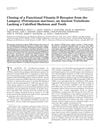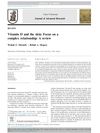TLDR The vitamin D receptor can affect gene activity even without its usual hormone in hair and skin.
The document discussed the molecular biology of the vitamin D receptor (VDR), which mediated the biological effects of 1,25-dihydroxyvitamin D3 by binding with high affinity and selectivity. The interaction of this hormone with VDR in target cells initiated a cascade of molecular events that altered gene transcription rates. Key aspects included VDR's macromolecular interactions, such as its binding with the 1,25(OH)2D ligand, DNA interaction mechanisms, heterodimeric interaction with retinoid X receptor (RXR), and protein-protein contacts with transcriptional machinery. Notably, recent data suggested that VDR had transcriptional activity independent of the 1,25(OH)2D ligand in hair follicles and skin, indicating a novel role for VDR with significant implications for its transcriptional mechanism.
148 citations
,
May 2008 in “The journal of investigative dermatology/Journal of investigative dermatology” Mice without the vitamin D receptor are more prone to UV-induced skin tumors.
36 citations
,
February 2007 in “Journal of biological chemistry/The Journal of biological chemistry” The vitamin D receptor can work without its usual activating molecule.
144 citations
,
December 2004 in “Molecular Endocrinology” The vitamin D receptor is essential for normal hair growth, even without its usual binding.
276 citations
,
April 2003 in “Molecular endocrinology” Vitamin D is important for bones, hair, blood pressure, and breast development.
137 citations
,
April 2001 in “Journal of Clinical Investigation” Alopecia in these mice is caused by defective hair cycle communication due to missing vitamin D receptor function, not vitamin D levels.
 25 citations
,
August 2014 in “Endocrinology”
25 citations
,
August 2014 in “Endocrinology” Researchers created a mouse model of a type of rickets that does not cause hair loss.
 104 citations
,
May 2003 in “Endocrinology”
104 citations
,
May 2003 in “Endocrinology” Lampreys have a functional vitamin D receptor that may help detoxify harmful substances.
62 citations
,
January 2009 in “Biochemistry” Vitamin D receptor binds similarly to natural and synthetic ligands, affecting gene regulation.
 1533 citations
,
October 2008 in “Endocrine reviews”
1533 citations
,
October 2008 in “Endocrine reviews” Mice without the vitamin D receptor have bone issues and other health problems, suggesting vitamin D is important for preventing various diseases in humans.
 1308 citations
,
March 1998 in “Journal of bone and mineral research”
1308 citations
,
March 1998 in “Journal of bone and mineral research” The vitamin D receptor is crucial for bone health and affects various body systems, with mutations potentially leading to disease.
 139 citations
,
February 2014 in “Journal of Advanced Research”
139 citations
,
February 2014 in “Journal of Advanced Research” Vitamin D is important for skin health and may affect conditions like psoriasis and hair loss, but more research is needed to understand its role fully.





